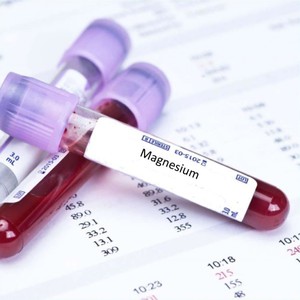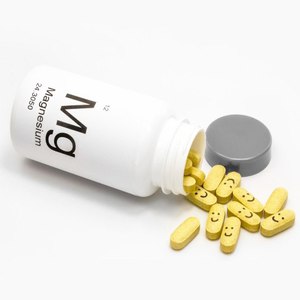A reliable source on many subjects.

A reliable source on many subjects.

![]()
 The majority of men and women suffer from magnesium deficiency and don’t consume enough of this vital substance.
The majority of men and women suffer from magnesium deficiency and don’t consume enough of this vital substance.
Every organ in your body, especially your muscles and heart, needs magnesium to function properly.
In fact, this mineral is involved in over 300 biochemical processes within your body.
In what follows, we’ll list the most common signs that can herald a magnesium deficiency.
But first, what are the causes of magnesium deficiency?
It is estimated that two-thirds of the Western population do not meet the recommended daily intake of magnesium. [1].
As a reminder, health authorities recommend an intake of 310 to 320mg for women and 400 to 420mg for men.
The primary cause of magnesium deficiency is diet.
Unfortunately, even if you eat enough foods rich in this mineral, your body may excrete large quantities of it if you also consume refined sugar, caffeinated drinks, soft drinks or alcohol.
Apart from diet, magnesium deficiency can be caused by aging, the use of certain medications or simply by certain gastrointestinal diseases and disorders such as Crohn’s disease and leaky gut.
Magnesium deficiency can manifest itself through a number of signs and symptoms.
Here are the most common symptoms (this list is not exhaustive).
Early signs of magnesium deficiency include :
Signs of severe magnesium deficiency:
 The easiest way to diagnose magnesium deficiency is to consult your doctor and explain your symptoms.
The easiest way to diagnose magnesium deficiency is to consult your doctor and explain your symptoms.
Since magnesium is found inside bones, muscles and brain tissue, it can be difficult to correctly determine the amount of magnesium in the body.
As a result, several tests have been developed to measure total magnesium levels.
There are currently five types of magnesium test available:
The serum magnesium test is the most common test for magnesium deficiency.
As the name suggests, this blood test checks magnesium levels in blood serum.
It’s probably the test your doctor will recommend if he or she suspects you’re suffering from magnesium deficiency, because it’s the most common screening method.
However, it should be noted that this test is limited and not very accurate, as most of the magnesium in the body is found in the cells.
Blood serum contains less than 1% of total magnesium!
So it’s quite possible for the test result to be normal, when in fact your overall magnesium levels are low. [2]!
The RBC magnesium test is another blood test that checks magnesium levels in cells.
More specifically, this test gives an overview of the amount of magnesium in red blood cells, hence the name RBC (for Red Blood Cell Count).
Generally speaking, the RBC test is considered a more accurate test than the serum test.
The ionic test is the least common blood test.
This test involves using a special machine to isolate magnesium ions, giving a more accurate reading of overall magnesium levels in the body.
Although more accurate than the other blood tests we’ve mentioned, access to the ion test remains very limited and can only be done in a few places.
Another method for detecting magnesium deficiency is the EXA test, which involves taking a blood sample.
Unlike blood tests, this test involves taking a small amount of soft tissue (where most of the magnesium is lodged) from the mouth, and then testing its magnesium content.
As with the ionic test, this test also requires specific test equipment.
As a result, it’s unlikely that you’ll find a doctor in your vicinity who has such equipment.
Finally, there’s the tolerance test. This test is neither a blood test nor a tissue sample test.
Instead, your doctor will give you a certain dose of magnesium and then analyze your urine.
The aim is to determine the ratio between the amount retained by your body and the amount eliminated via urine.
If your body retains more magnesium than it has eliminated, the doctor assumes that your body needed it and was therefore deficient.
If, on the other hand, most of it is eliminated in the urine, then supplementation was not necessary and you are not suffering from magnesium deficiency.
 In clinical practice, optimizing magnesium levels through diet and supplementation appears to be a safe, useful and well-documented therapy for many medical conditions.
In clinical practice, optimizing magnesium levels through diet and supplementation appears to be a safe, useful and well-documented therapy for many medical conditions.
In addition to eating magnesium-rich foods and limiting or avoiding refined sugar, soft drinks, caffeinated beverages and alcohol, you can also take a magnesium supplement.
And because magnesium needs to be bound to other substances for it to act effectively, it’s common to find it on supplement labels under other names such as magnesium citrate, magnesium oxide and magnesium glycinate, among others.
When choosing a magnesium supplement, it is advisable to opt for magnesium citrate, chelate and glycinate.
Note at this stage that magnesium oxide is not well absorbed and may cause loose stools.
Magnesium doesn’t work on its own.
For this reason, you should balance your magnesium intake with calcium, vitamin K2 and vitamin D. These four nutrients work together.

Diet and lifestyle play a key role in preventing magnesium deficiency.
Here are some simple and easy solutions to boost your magnesium intake: